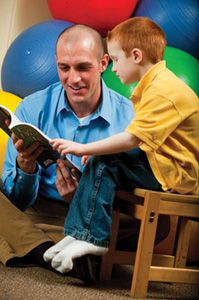By David Krupke,
Clinical Instructor, St. Ambrose University
Beneficence is defined as: the doing of good; active goodness or kindness; charity. This is a perfect term to describe the good works of the Iowa Scottish Rite Masonic Foundation here in eastern Iowa. Grant funding made available through the Iowa Scottish Rite over the past few years has resulted in speech-language services being provided, at no cost, not only to children and adults at the on-campus St. Ambrose University Rite Care Clinic in Davenport, Iowa, but also to children attending preschool and daycare programs through community organizations in the area.
Proof of benefit is often measured in terms of data in today’s society, but it is no secret that numbers don’t always tell the whole story. As Albert Einstein once said, “Not everything that counts can be counted.”
So what might you see that ultimately matters more than scores or ratings or checklists? What matters most is the response seen on the faces and in the voices of those who have been served, whether the response to service involves seven-year old boys running to their therapy room because they are excited about working with their graduate students, the warm, heart-felt “thank you” spoken by an adult client as they leave the clinic room, or preschoolers excitedly greeting the graduate students and clinical supervisor as they enter an off-site preschool room.
The partnering of St. Ambrose University Master of Speech-Language Pathology Program with Friendly House preschool has been beneficial to their programs, while at the same time, providing invaluable experiences for graduate students in speech-language therapy and early literacy skill development. The Friendly House Program Assistant Director shared these comments:
-
We are extremely grateful for the expertise the St. Ambrose students bring to our programs. Since 2009, they have provided prevention, enrichment, assessment, and treatment to children enrolled at our two sites. This adds quality to our programs that we could not afford if we had to purchase these services, as well as offering a real-life, real-kid experience which is extremely valuable for the [St. Ambrose] students.
When asked to reflect on the benefit of the St. Ambrose partnership, the Friendly Kid’s Corner Director commented:
-
We are so pleased to have St. Ambrose University students and staff volunteering their time—they have been a wonderful asset to our program. The assessments they performed have helped to identify speech-language delays and academic needs in our preschoolers, and significant improvement has been evident as a result of the graduate students working one-on-one with students who have speech-language delays. The Clinical Instructor from St. Ambrose has given the staff teaching tools that have been implemented into their classes in order to prepare children for Kindergarten. The children have been excited about Visual Phonics and the hands-on learning that has become part of our daily routine. Not only are the children excited, the parents are excited as well and have given us feedback about how much they appreciate St. Ambrose University involvement in our program.
Just as dropping a coin into a fountain causes ripples that radiate out from the center, so has the rippling of Scottish Rite beneficence radiated out from the St. Ambrose University Rite Care Clinic into the community.
Three stories come to mind to illustrate positive changes in children’s lives as a result of Scottish Rite grant funding:
- At age two, Zac was almost impossible to understand, and being a bright child with a lot to say, he was frustrated. Speech therapy was provided at his day care site by St. Ambrose graduate students and over the course of a year and a half, Zac made amazing progress and his speech is now understandable to everyone.
- Keeshana, age four, was difficult to understand and struggled in learning early literacy skills. For Keeshana, implementation of the “See the Sound/Visual Phonics” strategy provided an acceptable way to move and actively use her body while learning, and opened the door to the magic of letter names and sounds.
- Ginny, age ten, came to the Rite Care Clinic after several years of speech therapy in her local school for a distorted R sound. Her progress had been minimal through the years and most of her R sounds remained distorted. As a result of innovative therapy techniques for skill training, awareness building, and behavior change, Ginny was released after only four months of treatment.







